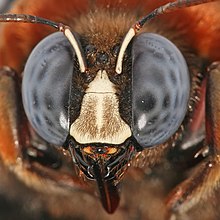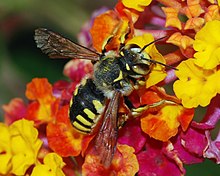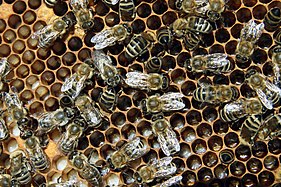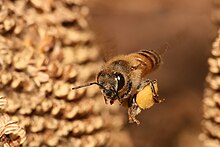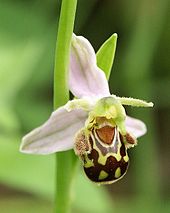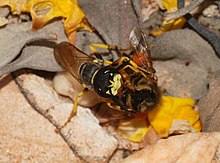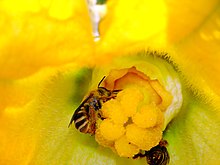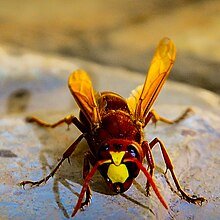| Bee | |
|---|---|

| |
| The sugarbag bee, Tetragonula carbonaria | |
| Scientific classification | |
| Kingdom: | Animalia |
| Phylum: | Arthropoda |
| Class: | Insecta |
| Order: | Hymenoptera |
| (unranked): | Unicalcarida |
| Suborder: | Apocrita |
| Superfamily: | Apoidea |
| Clade: | Anthophila |
| Families | |
| Synonyms | |
|
Apiformes (from Latin 'apis')
| |
Bees are flying insects closely related to wasps and ants, known for their role in pollination and, in the case of the best-known bee species, the western honey bee, for producing honey and beeswax. Bees are a monophyletic lineage within the superfamily Apoidea and are presently considered a clade, called Anthophila. There are over 16,000 known species of bees in seven recognized biological families. They are found on every continent except Antarctica, in every habitat on the planet that contains insect-pollinated flowering plants.
Some species — including honey bees, bumblebees, and stingless bees — live socially in colonies. Bees are adapted for feeding on nectar and pollen, the former primarily as an energy source and the latter primarily for protein and other nutrients. Most pollen is used as food for larvae. Bee pollination is important both ecologically and commercially. The decline in wild bees has increased the value of pollination by commercially managed hives of honey bees.
Bees range in size from tiny stingless bee species whose workers are less than 2 millimetres (0.08 in) long, to Megachile pluto, the largest species of leafcutter bee, whose females can attain a length of 39 millimetres (1.54 in). The most common bees in the Northern Hemisphere are the Halictidae, or sweat bees, but they are small and often mistaken for wasps or flies. Vertebrate predators of bees include birds such as bee-eaters; insect predators include beewolves and dragonflies.
Human beekeeping or apiculture has been practised for millennia, since at least the times of Ancient Egypt and Ancient Greece. Apart from honey and pollination, honey bees produce beeswax, royal jelly and propolis. Bees have appeared in mythology and folklore, through all phases of art and literature, from ancient times to the present day, though primarily focused in the Northern Hemisphere, where beekeeping is far more common.
The analysis of 353 wild bee and hoverfly species across Britain from 1980 to 2013 found the insects have been lost from a quarter of the places they inhabited in 1980.[3]
Evolution
Melittosphex burmensis, a fossil bee preserved in amber from the Early Cretaceous (100 to 145 million years ago) of Myanmar
The ancestors of bees were wasps in the family Crabronidae, which were predators
of other insects. The switch from insect prey to pollen may have
resulted from the consumption of prey insects which were flower visitors
and were partially covered with pollen when they were fed to the wasp
larvae. This same evolutionary scenario may have occurred within the vespoid wasps, where the pollen wasps evolved from predatory ancestors. Until recently, the oldest non-compression bee fossil had been found in New Jersey amber, Cretotrigona prisca of Cretaceous age, a corbiculate bee. A bee fossil from the early Cretaceous (~100 mya), Melittosphex burmensis, is considered "an extinct lineage of pollen-collecting Apoidea sister to the modern bees". Derived features of its morphology (apomorphies) place it clearly within the bees, but it retains two unmodified ancestral traits (plesiomorphies) of the legs (two mid-tibial spurs, and a slender hind basitarsus), showing its transitional status. By the Eocene (~45 mya) there was already considerable diversity among eusocial bee lineages.
The highly eusocial corbiculate Apidae appeared roughly 87 Mya, and the Allodapini (within the Apidae) around 53 Mya.
The Colletidae appear as fossils only from the late Oligocene (~25 Mya) to early Miocene.
The Melittidae are known from Palaeomacropis eocenicus in the Early Eocene.
The Megachilidae are known from trace fossils (characteristic leaf cuttings) from the Middle Eocene.
The Andrenidae are known from the Eocene-Oligocene boundary, around 34 Mya, of the Florissant shale.
The Halictidae first appear in the Early Eocene with species found in amber. The Stenotritidae are known from fossil brood cells of Pleistocene age.
Coevolution
Long-tongued bees and long-tubed flowers coevolved, like this Amegilla cingulata (Apidae) on Acanthus ilicifolius.
The earliest animal-pollinated flowers were shallow, cup-shaped blooms pollinated by insects such as beetles, so the syndrome of insect pollination was well established before the first appearance of bees. The novelty is that bees are specialized
as pollination agents, with behavioral and physical modifications that
specifically enhance pollination, and are the most efficient pollinating
insects. In a process of coevolution, flowers developed floral rewards such as nectar and longer tubes, and bees developed longer tongues to extract the nectar. Bees also developed structures known as scopal hairs and pollen baskets
to collect and carry pollen. The location and type differ among and
between groups of bees. Most species have scopal hairs on their hind
legs or on the underside of their abdomens. Some species in the family
Apidae have pollen baskets on their hind legs, while very few lack these and instead collect pollen in their crops. The appearance of these structures drove the adaptive radiation of the angiosperms, and, in turn, bees themselves.
Bees coevolved not only with flowers but it is believed that some
species coevolved with mites. Some provide tufts of hairs called
acarinaria that appear to provide lodgings for mites; in return, it is
believed that mites eat fungi that attack pollen, so the relationship in
this case may be mutualistc.
Phylogeny
External
This phylogenetic tree is based on Debevic et al, 2012, which used molecular phylogeny to demonstrate that the bees (Anthophila) arose from deep within the Crabronidae, which is therefore paraphyletic. The placement of the Heterogynaidae is uncertain. The small subfamily Mellininae was not included in this analysis.
| Apoidea |
| ||||||||||||||||||||||||||||||||||||||||||||||||
Internal
This cladogram of the bee families is based on Hedtke et al., 2013,
which places the former families Dasypodaidae and Meganomiidae as
subfamilies inside the Melittidae.[23] English names, where available, are given in parentheses.
| Anthophila (bees) |
| |||||||||||||||||||||||||||||||||||||||
Characteristics
The lapping mouthparts of a honey bee, showing labium and maxillae
Bees differ from closely related groups such as wasps by having branched or plume-like setae
(hairs), combs on the forelimbs for cleaning their antennae, small
anatomical differences in limb structure, and the venation of the hind
wings; and in females, by having the seventh dorsal abdominal plate
divided into two half-plates.
Bees have the following characteristics:
- A pair of large compound eyes which cover much of the surface of the head. Between and above these are three small simple eyes (ocelli) which provide information on light intensity.
- The antennae usually have 13segments in males and 12 in females, and are geniculate, having an elbow joint part way along. They house large numbers of sense organs that can detect touch (mechanoreceptors), smell and taste; and small, hairlike mechanoreceptors that can detect air movement so as to "hear" sounds.
- The mouthparts are adapted for both chewing and sucking by having both a pair of mandibles and a long proboscis for sucking up nectar.
- The thorax has three segments, each with a pair of robust legs, and a pair of membranous wings on the hind two segments. The front legs of corbiculate bees bear combs for cleaning the antennae, and in many species the hind legs bear pollen baskets, flattened sections with incurving hairs to secure the collected pollen. The wings are synchronised in flight, and the somewhat smaller hind wings connect to the forewings by a row of hooks along their margin which connect to a groove in the forewing.
- The abdomen has nine segments, the hindermost three being modified into the sting.
Head-on view of a carpenter bee, showing antennae, three ocelli, compound eyes, sensory bristles and mouthparts
The largest species of bee is thought to be Wallace's giant bee Megachile pluto, whose females can attain a length of 39 millimetres (1.54 in). The smallest species may be dwarf stingless bees in the tribe Meliponini whose workers are less than 2 millimetres (0.08 in) in length.
Sociality
Haplodiploid breeding system
Willing to die for their sisters: worker honey bees killed defending their hive against wasps, along with a dead wasp. Such altruistic behaviour may be favoured by the haplodiploid sex determination system of bees.
According to inclusive fitness
theory, organisms can gain fitness not just through increasing their
own reproductive output, but also that of close relatives. In
evolutionary terms, individuals should help relatives when Cost < Relatedness * Benefit. The requirements for eusociality are more easily fulfilled by haplodiploid species such as bees because of their unusual relatedness structure.
In haplodiploid species, females develop from fertilized eggs and males from unfertilized eggs. Because a male is haploid (has only one copy of each gene), his daughters (which are diploid,
with two copies of each gene) share 100% of his genes and 50% of their
mother's. Therefore, they share 75% of their genes with each other. This
mechanism of sex determination gives rise to what W. D. Hamilton termed "supersisters", more closely related to their sisters than they would be to their own offspring.
Workers often do not reproduce, but they can pass on more of their
genes by helping to raise their sisters (as queens) than they would by
having their own offspring (each of which would only have 50% of their
genes), assuming they would produce similar numbers. This unusual
situation has been proposed as an explanation of the multiple (at least
9) evolutions of eusociality within Hymenoptera.
Haplodiploidy is neither necessary nor sufficient for eusociality. Some eusocial species such as termites
are not haplodiploid. Conversely, all bees are haplodiploid but not all
are eusocial, and among eusocial species many queens mate with multiple
males, creating half-sisters that share only 25% of each-other's genes.
But, monogamy (queens mating singly) is the ancestral state for all
eusocial species so far investigated, so it is likely that haplodiploidy
contributed to the evolution of eusociality in bees.
Eusociality
A honey bee swarm
Bees may be solitary or may live in various types of communities. Eusociality appears to have originated from at least three independent origins in halictid bees. The most advanced of these are species with eusocial colonies; these are characterised by cooperative brood care and a division of labour into reproductive and non-reproductive adults, plus overlapping generations. This division of labour creates specialized groups within eusocial societies which are called castes.
In some species, groups of cohabiting females may be sisters, and if
there is a division of labour within the group, they are considered semisocial. The group is called eusocial if, in addition, the group consists of a mother (the queen) and her daughters (workers).
When the castes are purely behavioural alternatives, with no
morphological differentiation other than size, the system is considered
primitively eusocial, as in many paper wasps; when the castes are morphologically discrete, the system is considered highly eusocial.
True honey bees (genus Apis,
of which seven species are currently recognized) are highly eusocial,
and are among the best known insects. Their colonies are established by swarms, consisting of a queen and several hundred workers. There are 29 subspecies of one of these species, Apis mellifera, native to Europe, the Middle East, and Africa. Africanized bees are a hybrid strain of A. mellifera that escaped from experiments involving crossing European and African subspecies; they are extremely defensive.
Stingless bees are also highly eusocial. They practise mass provisioning, with complex nest architecture and perennial colonies also established via swarming.
A bumblebee carrying pollen in its pollen baskets (corbiculae)
Many bumblebees are eusocial, similar to the eusocial Vespidae such as hornets
in that the queen initiates a nest on her own rather than by swarming.
Bumblebee colonies typically have from 50 to 200 bees at peak
population, which occurs in mid to late summer. Nest architecture is
simple, limited by the size of the pre-existing nest cavity, and
colonies rarely last more than a year. In 2011, the International Union for Conservation of Nature set up the Bumblebee Specialist Group to review the threat status of all bumblebee species worldwide using the IUCN Red List criteria.
There are many more species of primitively eusocial than highly
eusocial bees, but they have been studied less often. Most are in the
family Halictidae,
or "sweat bees". Colonies are typically small, with a dozen or fewer
workers, on average. Queens and workers differ only in size, if at all.
Most species have a single season colony cycle, even in the tropics, and
only mated females hibernate. A few species have long active seasons
and attain colony sizes in the hundreds, such as Halictus hesperus. Some species are eusocial in parts of their range and solitary in others, or have a mix of eusocial and solitary nests in the same population. The orchid bees (Apidae) include some primitively eusocial species with similar biology. Some allodapine bees (Apidae) form primitively eusocial colonies, with progressive provisioning: a larva's food is supplied gradually as it develops, as is the case in honey bees and some bumblebees.
Solitary and communal bees
A leafcutting bee, Megachile rotundata, cutting circles from acacia leaves
Most other bees, including familiar insects such as carpenter bees, leafcutter bees and mason bees
are solitary in the sense that every female is fertile, and typically
inhabits a nest she constructs herself. There is no division of labor so
these nests lack queens and worker bees for these species. Solitary bees typically produce neither honey nor beeswax.
Bees collect pollen to feed their young, and have the necessary adaptations to do this. However, certain wasp species such as pollen wasps have similar behaviours, and a few species of bee scavenge from carcases to feed their offspring.
Solitary bees are important pollinators; they gather pollen to
provision their nests with food for their brood. Often it is mixed with
nectar to form a paste-like consistency. Some solitary bees have
advanced types of pollen-carrying structures on their bodies. Very few
species of solitary bee are being cultured for commercial pollination.
Most of these species belong to a distinct set of genera which are commonly known by their nesting behavior or preferences, namely: carpenter bees, sweat bees, mason bees, plasterer bees, squash bees, dwarf carpenter bees, leafcutter bees, alkali bees and digger bees.
Most solitary bees nest in the ground in a variety of soil textures and conditions while others create nests in hollow reeds or twigs, holes in wood.
The female typically creates a compartment (a "cell") with an egg and
some provisions for the resulting larva, then seals it off. A nest may
consist of numerous cells. When the nest is in wood, usually the last
(those closer to the entrance) contain eggs that will become males. The
adult does not provide care for the brood once the egg is laid, and
usually dies after making one or more nests. The males typically emerge
first and are ready for mating when the females emerge. Solitary bees
are either stingless or very unlikely to sting (only in self-defense, if
ever).
The mason bee Osmia cornifrons nests in a hole in dead wood. Bee "hotels" are often sold for this purpose.
While solitary, females each make individual nests. Some species, such as the European mason bee Hoplitis anthocopoides, and the Dawson's Burrowing bee, Amegilla dawsoni,
are gregarious, preferring to make nests near others of the same
species, and giving the appearance of being social. Large groups of
solitary bee nests are called aggregations, to distinguish them from colonies.
In some species, multiple females share a common nest, but each makes
and provisions her own cells independently. This type of group is called
"communal" and is not uncommon. The primary advantage appears to be
that a nest entrance is easier to defend from predators and parasites
when there are multiple females using that same entrance on a regular
basis.
Biology
Life cycle
The life cycle of a bee, be it a solitary or social species, involves
the laying of an egg, the development through several moults of a
legless larva, a pupation stage during which the insect undergoes complete metamorphosis,
followed by the emergence of a winged adult. Most solitary bees and
bumble bees in temperate climates overwinter as adults or pupae and
emerge in spring when increasing numbers of flowering plants come into
bloom. The males usually emerge first and search for females with which
to mate. The sex of a bee is determined by whether or not the egg is
fertilised; after mating, a female stores the sperm, and determines
which sex is required at the time each individual egg is laid,
fertilised eggs producing female offspring and unfertilised eggs, males.
Tropical bees may have several generations in a year and no diapause stage.
The egg is generally oblong, slightly curved and tapering at one
end. Solitary bees, lay each egg in a separate cell with a supply of
mixed pollen and nectar next to it. This may be rolled into a pellet or
placed in a pile and is known as mass provisioning. Social bee species
provision progressively, that is, they feed the larva regularly while it
grows. The nest varies from a hole in the ground or in wood, in
solitary bees, to a substantial structure with wax combs in bumblebees
and honey bees.
In most species, larvae are whitish grubs, roughly oval and bluntly-pointed at both ends. They have 15 segments and spiracles
in each segment for breathing. They have no legs but move within the
cell, helped by tubercles on their sides. They have short horns on the
head, jaws for chewing food and an appendage on either side of the mouth
tipped with a bristle. There is a gland under the mouth that secretes a
viscous liquid which solidifies into the silk they use to produce a
cocoon. The cocoon is semi-transparent and the pupa can be seen through
it. Over the course of a few days, the larva undergoes metamorphosis
into an winged adult. When ready to emerge, the adult splits its skin
dorsally and climbs out of the exuviae and breaks out of the cell.
- Nest of common carder bumblebee, wax canopy removed to show winged workers and pupae in irregularly placed wax cells
- Carpenter bee nests in a cedar wood beam (sawn open)
Flight
Honeybee in flight carrying pollen in pollen basket
Antoine Magnan's 1934 book Le vol des insectes, says that he and André Sainte-Laguë had applied the equations of air resistance to insects
and found that their flight could not be explained by fixed-wing
calculations, but that "One shouldn't be surprised that the results of
the calculations don't square with reality".
This has led to a common misconception that bees "violate aerodynamic
theory". In fact it merely confirms that bees do not engage in
fixed-wing flight, and that their flight is explained by other
mechanics, such as those used by helicopters. In 1996 it was shown that vortices created by many insects' wings helped to provide lift. High-speed cinematography and robotic mock-up of a bee wing
showed that lift was generated by "the unconventional combination of
short, choppy wing strokes, a rapid rotation of the wing as it flops
over and reverses direction, and a very fast wing-beat frequency".
Wing-beat frequency normally increases as size decreases, but as the
bee's wing beat covers such a small arc, it flaps approximately 230 times per second, faster than a fruitfly (200 times per second) which is 80 times smaller.
Karl von Frisch (1953) discovered that honey bee workers can navigate, indicating the range and direction to food to other workers with a waggle dance.
The ethologist Karl von Frisch studied navigation in the honey bee. He showed that honey bees communicate by the waggle dance,
in which a worker indicates the location of a food source to other
workers in the hive. He demonstrated that bees can recognize a desired
compass direction in three different ways: by the sun, by the polarization
pattern of the blue sky, and by the earth's magnetic field. He showed
that the sun is the preferred or main compass; the other mechanisms are
used under cloudy skies or inside a dark beehive. Bees navigate using spatial memory with a "rich, map-like organization".
Digestion
The gut of bees is relatively simple, but multiple metabolic strategies exist in the gut microbiota.
Pollinating bees consume nectar and pollen, which require different
digestion strategies by somewhat specialized bacteria. While nectar is a
liquid of mostly monosaccharide sugars and so easily absorbed, pollen contains complex polysaccharides: branching pectin and hemicellulose. Approximately five groups of bacteria are involved in digestion. Three groups specialize in simple sugars (Snodgrassella and two groups of Lactobacillus), and two other groups in complex sugars (Gilliamella and Bifidobacterium). Digestion of pectin and hemicellulose is dominated by bacterial clades Gilliamella and Bifidobacterium
respectively. Bacteria that cannot digest polysaccharides obtain
enzymes from their neighbors, and bacteria that lack certain amino acids
do the same, creating multiple ecological niches.
Although most bee species are nectarivorous and palynivorous, some are not. Particularly unusual are vulture bees in the genus Trigona, which consume carrion and wasp brood, turning meat into a honey-like substance.
Ecology
Floral relationships
Most bees are polylectic (generalist) meaning they collect pollen from a range of flowering plants, but some are oligoleges (specialists), in that they only gather pollen from one or a few species or genera of closely related plants.
Specialist pollinators also include bee species which gather floral
oils instead of pollen, and male orchid bees, which gather aromatic
compounds from orchids
(one of the few cases where male bees are effective pollinators). Bees
are able to sense the presence of desirable flowers through ultraviolet
patterning on flowers, floral odors, and even electromagnetic fields. Once landed, a bee then uses nectar quality and pollen taste to determine whether to continue visiting similar flowers.
In rare cases, a plant species may only be effectively pollinated by a single bee species, and some plants are endangered
at least in part because their pollinator is also threatened. But,
there is a pronounced tendency for oligolectic bees to be associated
with common, widespread plants visited by multiple pollinator species.
For example, the creosote bush in the arid parts of the United States southwest is associated with some 40 oligoleges.
As mimics and models
The bee-fly Bombylius major, a Batesian mimic of bees, taking nectar and pollinating a flower.
Bee orchid lures male bees to attempt to mate with the flower's lip, which resembles a bee perched on a pink flower.
Many bees are aposematically
coloured, typically orange and black, warning of their ability to
defend themselves with a powerful sting. As such they are models for Batesian mimicry by non-stinging insects such as bee-flies, robber flies and hoverflies, all of which gain a measure of protection by superficially looking and behaving like bees.
Bees are themselves Müllerian mimics of other aposematic insects with the same colour scheme, including wasps, lycid and other beetles, and many butterflies and moths (Lepidoptera)
which are themselves distasteful, often through acquiring bitter and
poisonous chemicals from their plant food. All the Müllerian mimics,
including bees, benefit from the reduced risk of predation that results
from their easily recognised warning coloration.
Bees are also mimicked by plants such as the bee orchid which imitates both the appearance and the scent of a female bee; male bees attempt to mate (pseudocopulation) with the furry lip of the flower, thus pollinating it.
As brood parasites
Brood parasites occur in several bee families including the apid subfamily Nomadinae. Females of these species lack pollen collecting structures (the scopa)
and do not construct their own nests. They typically enter the nests of
pollen collecting species, and lay their eggs in cells provisioned by
the host bee. When the "cuckoo" bee larva hatches, it consumes the host
larva's pollen ball, and often the host egg also. In particular, the Arctic bee species, Bombus hyperboreus
is an aggressive species that attacks and enslaves other bees of the
same subgenus. However, unlike many other bee brood parasites, they have
pollen baskets and often collect pollen.
In Southern Africa, hives of African honeybees (A. mellifera scutellata) are being destroyed by parasitic workers of the Cape honeybee, A. m. capensis. These lay diploid eggs ("thelytoky"), escaping normal worker policing, leading to the colony's destruction; the parasites can then move to other hives.
The cuckoo bees in the Bombus subgenus Psithyrus
are closely related to, and resemble, their hosts in looks and size.
This common pattern gave rise to the ecological principle "Emery's rule". Others parasitize bees in different families, like Townsendiella, a nomadine apid, two species of which are cleptoparasites of the dasypodaid genus Hesperapis, while the other species in the same genus attacks halictid bees.
Nocturnal bees
Four bee families (Andrenidae, Colletidae, Halictidae, and Apidae) contain some species that are crepuscular. Most are tropical or subtropical, but some live in arid regions at higher latitudes. These bees have greatly enlarged ocelli,
which are extremely sensitive to light and dark, though incapable of
forming images. Some have refracting superposition compound eyes: these
combine the output of many elements of their compound eyes to provide
enough light for each retinal photoreceptor. Their ability to fly by
night enables them to avoid many predators, and to exploit flowers that
produce nectar only or also at night.
Predators, parasites and pathogens
The bee-eater, Merops apiaster, specialises in feeding on bees; here a male catches a nuptial gift for his mate.
Vertebrate predators of bees include bee-eaters, shrikes and flycatchers, which make short sallies to catch insects in flight. Swifts and swallows fly almost continually, catching insects as they go. The honey buzzard attacks bees' nests and eats the larvae. The greater honeyguide
interacts with humans by guiding them to the nests of wild bees. The
humans break open the nests and take the honey and the bird feeds on the
larvae and the wax. Among mammals, predators such as the badger dig up bumblebee nests and eat both the larvae and any stored food.
The beewolf Philanthus triangulum paralysing a bee with its sting
Specialist ambush predators of visitors to flowers include crab spiders, which wait on flowering plants for pollinating insects; predatory bugs, and praying mantises, some of which (the flower mantises of the tropics) wait motionless, aggressive mimics camouflaged as flowers. Beewolves are large wasps that habitually attack bees; the ethologist Niko Tinbergen estimated that a single colony of the beewolf Philanthus triangulum might kill several thousand honeybees in a day: all the prey he observed were honeybees. Other predatory insects that sometimes catch bees include robber flies and dragonflies. Honey bees are affected by parasites including acarine and Varroa mites. However, some bees are believed to have a mutualistic relationship with mites.
Relationship with humans
In mythology and folklore
Homer's Hymn to Hermes, describes three bee maidens with the power of divination and thus speaking truth, and identifies the food of the gods as honey; the bee maidens were originally associated with Apollo, and are probably not correctly identified with the Thriae.[citation needed]
Honey, according to a Greek myth, was discovered by a nymph called
Melissa ("Bee"); and honey was offered to the Greek gods from Mycenean times. Bees were also associated with the Delphic oracle and the prophetess was sometimes called a bee.
The image of a community of honey bees has been used from ancient to modern times, in Aristotle and Plato; in Virgil and Seneca; in Erasmus and Shakespeare; Tolstoy, and by political and social theorists such as Bernard Mandeville and Karl Marx as a model for human society. In English folklore, bees would be told of important events in the household, in a custom known as "Telling the bees".
In art and literature
Beatrix Potter's illustration of Babbity Bumble in The Tale of Mrs Tittlemouse, 1910
Some of the oldest examples of bees in art are rock paintings in Spain which have been dated to 15,000 BC.
W. B. Yeats's poem The Lake Isle of Innisfree
(1888) contains the couplet "Nine bean rows will I have there, a hive
for the honey bee, / And live alone in the bee loud glade." At the time
he was living in Bedford Park in the West of London. Beatrix Potter's illustrated book The Tale of Mrs Tittlemouse (1910) features Babbity Bumble and her brood (pictured). Kit Williams' treasure hunt book The Bee on the Comb (1984) uses bees and beekeeping as part of its story and puzzle. Sue Monk Kidd's The Secret Life of Bees (2004), and the 2009 film starring Dakota Fanning, tells the story of a girl who escapes her abusive home and finds her way to live with a family of beekeepers, the Boatwrights.
The humorous 2007 animated film Bee Movie used Jerry Seinfeld's first script and was his first work for children; he starred as a bee named Barry B. Benson, alongside Renée Zellweger. Critics found its premise awkward and its delivery tame. Dave Goulson's A Sting in the Tale (2014) describes his efforts to save bumblebees in Britain, as well as much about their biology. The playwright Laline Paull's fantasy The Bees (2015) tells the tale of a hive bee named Flora 717 from hatching onwards.
Beekeeping
A commercial beekeeper at work
Humans have kept honey bee colonies, commonly in hives, for millennia. Beekeepers collect honey, beeswax, propolis, pollen, and royal jelly from hives; bees are also kept to pollinate crops and to produce bees for sale to other beekeepers.
Depictions of humans collecting honey from wild bees date to
15,000 years ago; efforts to domesticate them are shown in Egyptian art
around 4,500 years ago. Simple hives and smoke were used; jars of honey were found in the tombs of pharaohs such as Tutankhamun.
From the 18th century, European understanding of the colonies and
biology of bees allowed the construction of the moveable comb hive so
that honey could be harvested without destroying the colony. Among Classical Era authors, beekeeping with the use of smoke is described in Aristotle's History of Animals Book 9.
The account mentions that bees die after stinging; that workers remove
corpses from the hive, and guard it; castes including workers and
non-working drones, but "kings" rather than queens; predators including toads and bee-eaters; and the waggle dance,
with the "irresistible suggestion" of άpοσειονται ("aroseiontai", it
waggles) and παρακολουθούσιν ("parakolouthousin", they watch).
Beekeeping is described in detail by Virgil in his Eclogues; it is also mentioned in his Aeneid, and in Pliny's Natural History.
As commercial pollinators
Bees play an important role in pollinating flowering plants, and are the major type of pollinator in many ecosystems that contain flowering plants. It is estimated that one third of the human food supply depends on pollination by insects, birds and bats, most of which is accomplished by bees, whether wild or domesticated.
Over the last half century, there has been a general decline in the
species richness of wild bees and other pollinators, probably
attributable to stress from increased parasites and disease, the use of
pesticides, and a general decrease in the number of wild flowers.
Climate change probably exacerbates the problem.
Contract pollination has overtaken the role of honey production for beekeepers in many countries. After the introduction of Varroa mites, feral honey bees declined dramatically in the US, though their numbers have since recovered. The number of colonies kept by beekeepers declined slightly, through urbanization, systematic pesticide use, tracheal and Varroa mites, and the closure of beekeeping businesses. In 2006 and 2007 the rate of attrition increased, and was described as colony collapse disorder. In 2010 invertebrate iridescent virus and the fungus Nosema ceranae were shown to be in every killed colony, and deadly in combination. Winter losses increased to about 1/3. Varroa mites were thought to be responsible for about half the losses.
Apart from colony collapse disorder, losses outside the US have
been attributed to causes including pesticide seed dressings, using neonicotinoids such as Clothianidin, Imidacloprid and Thiamethoxam. From 2013 the European Union restricted some pesticides to stop bee populations from declining further. In 2014 the Intergovernmental Panel on Climate Change report warned that bees faced increased risk of extinction because of global warming.
In 2018 the European Union decided to ban field use of all three major
neonicotinoids; they remain permitted in veterinary, greenhouse, and
vehicle transport usage.
Farmers have focused on alternative solutions to mitigate these
problems. By raising native plants, they provide food for native bee
pollinators like Lasioglossum vierecki and L. leucozonium, leading to less reliance on honey bee populations.
As food producers
Honey is a natural product produced by bees and stored for their own
use, but its sweetness has always appealed to humans. Before
domestication of bees was even attempted, humans were raiding their
nests for their honey. Smoke was often used to subdue the bees and such
activities are depicted in rock paintings in Spain dated to 15,000 BC.
Honey bees are used commercially to produce honey. They also produce some substances used as dietary supplements with possible health benefits, pollen, propolis, and royal jelly, though all of these can also cause allergic reactions.
As food (bee brood)
Bee larvae as food in the Javanese dish botok tawon
Bees are partly considered edible insects. Indigenous people in many countries eat insects,
including the larvae and pupae of bees, mostly stingless species. They
also gather larvae, pupae and surrounding cells, known as bee brood, for consumption. In the Indonesian dish botok tawon from Central and East Java, bee larvae are eaten as a companion to rice, after being mixed with shredded coconut, wrapped in banana leaves, and steamed.
Bee brood (pupae and larvae) although low in calcium, has been found to be high in protein and carbohydrate, and a useful source of phosphorus, magnesium, potassium, and trace minerals iron, zinc, copper, and selenium.
In addition, while bee brood was high in fat, it contained no fat
soluble vitamins (such as A, D, and E) but it was a good source of most
of the water-soluble B-vitamins including choline as well as vitamin C. The fat was composed mostly of saturated and monounsaturated fatty acids with 2.0% being polyunsaturated fatty acids.
As alternative medicine
Apitherapy is a branch of alternative medicine that uses honey bee products, including raw honey, royal jelly, pollen, propolis, beeswax and apitoxin (Bee venom). The claim that apitherapy treats cancer, which some proponents of apitherapy make, remains unsupported by evidence-based medicine.
Stings
The painful stings of bees are mostly associated with the poison gland and the Dufour's gland which are abdominal exocrine glands containing various chemicals. In Lasioglossum leucozonium, the Dufour's Gland mostly contains octadecanolide as well as some eicosanolide. There is also evidence of n-triscosane, n-heptacosane, and 22-docosanolide. However, the secretions of these glands could also be used for nest construction.














